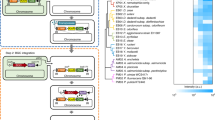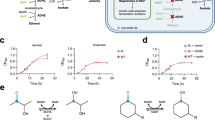Abstract
Escherichia coli can derive all essential metabolites and cofactors through a highly evolved metabolic system. Damage of pathways may affect cell growth and physiology, but the strategies by which damaged metabolic pathways can be circumvented remain intriguing. Here, we use a ΔpanD (encoding for aspartate 1-decarboxylase) strain of E. coli that is unable to produce the β-alanine required for CoA biosynthesis to demonstrate that metabolic systems can overcome pathway damage by extensively rerouting metabolic pathways and modifying existing enzymes for unnatural functions. Using directed cell evolution, rewiring and repurposing of uracil metabolism allowed formation of an alternative β-alanine biosynthetic pathway. After this pathway was deleted, a second was evolved that used a gain-of-function mutation on ornithine decarboxylase (SpeC) to alter reaction and substrate specificity toward an oxidative decarboxylation–deamination reaction. After deletion of both pathways, yet another independent pathway emerged using polyamine biosynthesis, demonstrating the vast capacity of metabolic repair.
This is a preview of subscription content, access via your institution
Access options
Access Nature and 54 other Nature Portfolio journals
Get Nature+, our best-value online-access subscription
$29.99 / 30 days
cancel any time
Subscribe to this journal
Receive 12 print issues and online access
$259.00 per year
only $21.58 per issue
Buy this article
- Purchase on Springer Link
- Instant access to full article PDF
Prices may be subject to local taxes which are calculated during checkout




Similar content being viewed by others
Data availability
The data that support the findings of this study are available from the corresponding author upon reasonable request. All genomic sequences are available at NCBI under BioProject ID PRJNA485586.
References
Patrick, W. M., Quandt, E. M., Swartzlander, D. B. & Matsumura, I. Multicopy suppression underpins metabolic evolvability. Mol. Biol. Evol. 24, 2716–2722 (2006).
Notebaart, R. A., Kintses, B., Feist, A. M. & Papp, B. Underground metabolism: network-level perspective and biotechnological potential. Curr. Opin. Biotechnol. 49, 108–114 (2018).
McLoughlin, S. Y. & Copley, S. D. A compromise required by gene sharing enables survival: implications for evolution of new enzyme activities. Proc. Natl Acad. Sci. USA 105, 13497–13502 (2008).
Blank, D., Wolf, L., Ackermann, M. & Silander, O. K. The predictability of molecular evolution during functional innovation. Proc. Natl Acad. Sci. USA 111, 3044–3049 (2014).
Reed, J. L., Vo, T. D., Schilling, C. H. & Palsson, B. O. An expanded genome-scale model of Escherichia coli K-12 (i JR904 GSM/GPR). genome Biol. 4, R54 (2003).
Guzmán, G. I. et al. Model-driven discovery of underground metabolic functions in Escherichia coli. Proc. Natl Acad. Sci. USA 112, 929–934 (2015).
Khersonsky, O. & Tawfik, D. S. Enzyme promiscuity: a mechanistic and evolutionary perspective. Annu. Rev. Biochem. 79, 471–505 (2010).
Kim, J., Kershner, J. P., Novikov, Y., Shoemaker, R. K. & Copley, S. D. Three serendipitous pathways in E. coli can bypass a block in pyridoxal-5′-phosphate synthesis. Mol. Syst. Biol. 6, 436 (2010).
Webb, M. E., Smith, A. G. & Abell, C. Biosynthesis of pantothenate. Nat. Prod. Rep. 21, 695–721 (2004).
Boldyrev, A. A. Carnosine: new concept for the function of an old molecule. Biochemistry (Mosc). 77, 313–326 (2012).
Joanne, W. M. & Brown, G. M. Purification and properties of l-aspartate-α-decarboxylase, an enzyme that catalyzes the formation of β-alanine in Escherichia coli. J. Biol. Chem. 254, 8074–8082 (1979).
Nozaki, S., Webb, M. E. & Niki, H. An activator for pyruvoyl-dependent ʟ-aspartate α-decarboxylase is conserved in a small group of the γ-proteobacteria including Escherichia coli. MicrobiologyOpen 1, 298–310 (2012).
Rathinasabapathi, B. Propionate, a source of β-alanine, is an inhibitor of β-alanine methylation in Limonium latifolium, Plumbaginaceae. J. Plant Physiol. 159, 671–674 (2002).
Fritzson, P. The catabolism of C14-labeled uracil, dihydrouracil, and β-ureidopropionic acid in rat liver slices. J. Biol. Chem. 226, 223–228 (1957).
White, W. H., Gunyuzlu, P. L. & Toyn, J. H. Saccharomyces cerevisiae is capable of de novo pantothenic acid biosynthesis involving a novel pathway of beta-alanine production from spermine. J. Biol. Chem. 276, 10794–10800 (2001).
Maruyama, M., Horiuchi, T., Maki, H. & Sekiguchi, M. A dominant (mut D5) and a recessive (dnaQ49) mutator of Escherichia coli. J. Mol. Biol. 167, 757–771 (1983).
Kim, K. S. et al. The Rut pathway for pyrimidine degradation: novel chemistry and toxicity problems. J. Bacteriol. 192, 4089–4102 (2010).
Borodina, I. et al. Establishing a synthetic pathway for high-level production of 3-hydroxypropionic acid in Saccharomyces cerevisiae via β-alanine. Metab. Eng. 27, 57–64 (2015).
Andersen, P. S., Smith, J. M. & Mygind, B. Characterization of the upp gene encoding uracil phosphoribosyltransferase of Escherichia coli K12. Eur. J. Biochem. 204, 51–56 (1992).
Bertoldi, M., Carbone, V. & Borri Voltattorni, C. Ornithine and glutamate decarboxylases catalyse an oxidative deamination of their α-methyl substrates. Biochem. J. 342, 509–512 (1999).
Kaminaga, Y. et al. Plant phenylacetaldehyde synthase is a bifunctional homotetrameric enzyme that catalyzes phenylalanine decarboxylation and oxidation. J. Biol. Chem. 281, 23357–23366 (2006).
Incharoensakdi, A. et al. Overproduction of spinach betaine aldehyde dehydrogenase in Escherichia coli. Structural and functional properties of wild-type, mutants and E. coli enzymes. Eur. J. Biochem. 267, 7015–7023 (2000).
Baba, T. et al. Construction of Escherichia coli K-12 in-frame, single-gene knockout mutants: the Keio collection. Mol. Syst. Biol. 2, 2006.0008 (2006).
Espah Borujeni, A., Channarasappa, A. S. & Salis, H. M. Translation rate is controlled by coupled trade-offs between site accessibility, selective RNA unfolding and sliding at upstream standby sites. Nucleic Acids Res. 42, 2646–2659 (2014).
Salis, H. M., Mirsky, E. A. & Voigt, C. A. Automated design of synthetic ribosome binding sites to control protein expression. Nat. Biotechnol. 27, 946–950 (2009).
Datsenko, K. A. & Wanner, B. L. One-step inactivation of chromosomal genes in Escherichia coli K-12 using PCR products. Proc. Natl Acad. Sci. USA 97, 6640–6645 (2000).
Degnen, G. E. & Cox, E. C. Conditional mutator gene in Escherichia coli: isolation, mapping, and effector studies. J. Bacteriol. 117, 477–487 (1974).
Livingston, D. Deoxyribonucleaic acid polymerase III of Escherichia coli. J. Biol. Chem. 250, 489–497 (1975).
Jensen, K. F. & Mygind, B. Different oligomeric states are involved in the allosteric behavior of uracil phosphoribosyltransferase from Escherichia coli. Eur. J. Biochem. 240, 637–645 (1996).
Wernick, D. G., Pontrelli, S. P., Pollock, A. W. & Liao, J. C. Sustainable biorefining in wastewater by engineered extreme alkaliphile Bacillus marmarensis. Sci. Rep. 6, 20224 (2016).
Canellakis, E. S., Paterakis, A. A., Huang, S. C., Panagiotidis, C. A. & Kyriakidis, D. A. Identification, cloning, and nucleotide sequencing of the ornithine decarboxylase antizyme gene of Escherichia coli. Proc. Natl Acad. Sci. USA 90, 7129–7133 (1993).
Choi, K. Y., Wernick, D. G., Tat, C. A. & Liao, J. C. Consolidated conversion of protein waste into biofuels and ammonia using Bacillus subtilis. Metab. Eng. 23, 53–61 (2014).
Applebaum, D. M., Dunlap, J. C. & Morris, D. R. Comparison of the biosynthetic and biodegradative ornithine decarboxylases of Escherichia coli. Biochemistry 16, 1580–1584 (1977).
Smart, K. F., Aggio, R. B. M., Van Houtte, J. R. & Villas-Bôas, S. G. Analytical platform for metabolome analysis of microbial cells using methyl chloroformate derivatization followed by gas chromatography-mass spectrometry. Nat. Protoc. 5, 1709–1729 (2010).
Li, H. & Durbin, R. Fast and accurate long-read alignment with Burrows-Wheeler transform. Bioinformatics 26, 589–595 (2010).
McKenna, A. et al. The Genome Analysis Toolkit: a MapReduce framework for analyzing next-generation DNA sequencing data. Genome Res. 20, 1297–1303 (2010).
Cingolani, P. et al. A program for annotating and predicting the effects of single nucleotide polymorphisms, SnpEff: SNPs in the genome of Drosophila melanogaster strainw1118; iso-2; iso-3. Fly (Austin) 6, 80–92 (2012).
Untergasser, A. et al. Primer3--new capabilities and interfaces. Nucleic Acids Res. 40, e115 (2012).
Liu, M. et al. Global transcriptional programs reveal a carbon source foraging strategy by Escherichia coli. J. Biol. Chem. 280, 15921–15927 (2005).
Acknowledgements
This research was supported in part by a grant from National Science Foundation (MCB-1139318) for JP-US “Metabolomics for Low Carbon Society” (received by J.C.L.), and Japan Science and Technology’s Strategic International Collaborative Research Program (received by E.F). S.F.-G. acknowledges support from a QCB Collaboratory Postdoctoral Fellowship, and the QCB Collaboratory community directed by M. Pellegrini.
Author information
Authors and Affiliations
Contributions
J.C.L. and S.P. conceived the idea of this project and wrote the manuscript. S.P. designed all experiments and performed evolution, RT-qPCR, enzyme assays, gene deletions, genome sequencing library generation, mass spec verification and measured growth phenotypes. R.C.B.F. performed evolution, enzyme assays, point mutation reversions, and growth curve analysis. S.T.T., W.A.L., S.P.P. and E.F. performed metabolomic analysis and data analysis. M.C. performed evolution. S.F.-G. and M.P. performed genomic sequencing and analysis.
Corresponding author
Ethics declarations
Competing interests
The authors declare no competing interests.
Additional information
Publisher’s note: Springer Nature remains neutral with regard to jurisdictional claims in published maps and institutional affiliations.
Supplementary information
Supplementary Information
Supplementary Figures 1–9, Supplementary Tables 1–10
Rights and permissions
About this article
Cite this article
Pontrelli, S., Fricke, R.C.B., Teoh, S.T. et al. Metabolic repair through emergence of new pathways in Escherichia coli. Nat Chem Biol 14, 1005–1009 (2018). https://doi.org/10.1038/s41589-018-0149-6
Received:
Accepted:
Published:
Issue Date:
DOI: https://doi.org/10.1038/s41589-018-0149-6
This article is cited by
-
Analyzing the genetic characteristics of a tryptophan-overproducing Escherichia coli
Bioprocess and Biosystems Engineering (2021)



